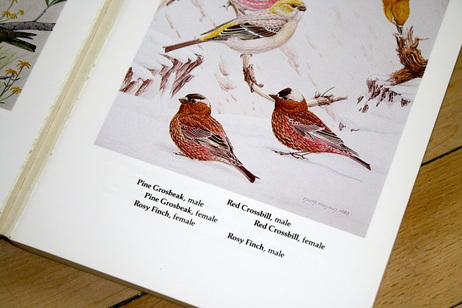 Gray-crowned rosy-finches, from "Discovering Sierra Birds" by Keith Hansen
Gray-crowned rosy-finches, from "Discovering Sierra Birds" by Keith Hansen Several years ago I spent a winter living in Montana. Here is a story from that time.
Since moving to Montana, I had been doing casual birding around Livingston. Spoiled by the warm, dry weather in southern California, from where I had just come, the cold, windy weather in Montana made me reluctant to go outside for long periods of time.
Finally, I had had enough. I had to go for a serious bird watching trip. It was time to go on a local birding expedition outside of Livingston to start finding some of Montana’s winter specialties.
Since moving to Montana, I had been doing casual birding around Livingston. Spoiled by the warm, dry weather in southern California, from where I had just come, the cold, windy weather in Montana made me reluctant to go outside for long periods of time.
Finally, I had had enough. I had to go for a serious bird watching trip. It was time to go on a local birding expedition outside of Livingston to start finding some of Montana’s winter specialties.
I had written up a list of my most wanted birds. Included on that list was the gray-crowned rosy-finch.
I had searched for these guys, with brown, grey, and pink plumage, while back-packing in the eastern Sierras in California, a few months before, in September. One book, "Discovering Sierra Birds" by Keith Hansen, had described them as being abundant above 10000 feet. I spent several days above 10000 feet, examining every small bird I saw. None were rosy-finches. Maybe they were moving to lower elevations because winter was coming. I kept my eyes peeled below 10000 feet. No rosy-finches. I had my boyfriend, Aaron, looking too. No rosy-finches.
I had searched for these guys, with brown, grey, and pink plumage, while back-packing in the eastern Sierras in California, a few months before, in September. One book, "Discovering Sierra Birds" by Keith Hansen, had described them as being abundant above 10000 feet. I spent several days above 10000 feet, examining every small bird I saw. None were rosy-finches. Maybe they were moving to lower elevations because winter was coming. I kept my eyes peeled below 10000 feet. No rosy-finches. I had my boyfriend, Aaron, looking too. No rosy-finches.
It became a joke between us. We started calling the finches the Pink Ones, mysterious pinkish birds sitting up on the highest Sierra peaks, giggling while we looked for them. At the end of our trip, as we drove through the Owens Valley and past Mount Whitney, I waved at the jagged peak, and at the Pink Ones, promising that I would find them one day.
After we moved up to Montana, I started perusing my field guides. I learned that grey-crowned rosy-finches were found in Montana in the winter. Good, I would find them here.
I set up my first serious Montana birding trip. My next tasks, after creating my most wanted list, were checking e-Bird, an online birding database that is popular among birders, and the Montana Outdoor Birding Group message-board. I focused on mentions of my most wanted birds, in particular the Pink Ones….aka, rosy-finches. I found several reports of sightings. In the end, I decided to head to the Shields Valley, since several life birds were possible there, including rosy-finches.
After we moved up to Montana, I started perusing my field guides. I learned that grey-crowned rosy-finches were found in Montana in the winter. Good, I would find them here.
I set up my first serious Montana birding trip. My next tasks, after creating my most wanted list, were checking e-Bird, an online birding database that is popular among birders, and the Montana Outdoor Birding Group message-board. I focused on mentions of my most wanted birds, in particular the Pink Ones….aka, rosy-finches. I found several reports of sightings. In the end, I decided to head to the Shields Valley, since several life birds were possible there, including rosy-finches.
Early in the morning, I set out on my trip. Snacks and coffee available, binoculars and camera easily accessible. Outside of Livingston, I headed north up Route 89 toward Clyde Park, watching for the road I wanted to take, Shields River Road. I saw it as I was driving past it. Dammit! I kept heading north, looking for a good place to turn my little Pontiac Sunfire around.
A couple of miles up the road, I noticed a big fluffy bird of prey sitting on a fence post, by a pasture full of cattle. It was a rough-legged hawk, a common winter raptor in Montana. Arctic breeders, they have fluffy plumage, dainty beaks, and small feet, and are probably one of the cutest hawks out there. It was sitting in a good spot for a photo. I took note of it, and when I turned around, I made a point of stopping to try for a picture.
Cars can make pretty good blinds. The hawk did not mind my car, my open window, or me pointing a camera at it. I felt optimistic about getting a great photo. Unfortunately, I accidently triggered the timer on the camera, causing the camera to beep loudly. The hawk minded this beeping a great deal, and took off over the backs of the cattle, landing in a tree too far away for a good photo. Oh well, maybe another day.
I continued on to my original destination. I drove through the valley slowly, watching for small birds along the road and in the fields, looking for longspurs, snow buntings, horned larks, and, of course, rosy-finches.
I encountered no small songbirds the entire length of the road. There were groups of pigeons hanging out here and there, lots of black-billed magpies, more rough-legged hawks (none in a good place for a photo), bald eagles, golden eagles, and ravens. At one point I spotted some fat brownish birds in a field near the road. Since sharp-tailed grouse was on my most wanted list, I stopped. They turned out to be gray partridge, an introduced gamebird. So, not sharp-tailed grouse, but still a new bird to me.
A couple of miles up the road, I noticed a big fluffy bird of prey sitting on a fence post, by a pasture full of cattle. It was a rough-legged hawk, a common winter raptor in Montana. Arctic breeders, they have fluffy plumage, dainty beaks, and small feet, and are probably one of the cutest hawks out there. It was sitting in a good spot for a photo. I took note of it, and when I turned around, I made a point of stopping to try for a picture.
Cars can make pretty good blinds. The hawk did not mind my car, my open window, or me pointing a camera at it. I felt optimistic about getting a great photo. Unfortunately, I accidently triggered the timer on the camera, causing the camera to beep loudly. The hawk minded this beeping a great deal, and took off over the backs of the cattle, landing in a tree too far away for a good photo. Oh well, maybe another day.
I continued on to my original destination. I drove through the valley slowly, watching for small birds along the road and in the fields, looking for longspurs, snow buntings, horned larks, and, of course, rosy-finches.
I encountered no small songbirds the entire length of the road. There were groups of pigeons hanging out here and there, lots of black-billed magpies, more rough-legged hawks (none in a good place for a photo), bald eagles, golden eagles, and ravens. At one point I spotted some fat brownish birds in a field near the road. Since sharp-tailed grouse was on my most wanted list, I stopped. They turned out to be gray partridge, an introduced gamebird. So, not sharp-tailed grouse, but still a new bird to me.
I returned to 89 without seeing any small songbirds. It was looking like the Pink Ones would evade me again. Bummer. I decided to keep going through Clyde Park, because I wanted to head to 86 and Bozeman after my birding excursion.
Outside of Clyde Park, I spotted an interesting scene: a road-killed deer covered in black-billed magpies. Magpies are common in the American west, and considered a pest by some. But I think they are one of the most beautiful birds, with their crisp black-and-white plumage, and long elegant tails, tinged with rainbow iridescence. This was a great opportunity to get photos of magpies, so I took the opportunity to get several dozen.
Outside of Clyde Park, I spotted an interesting scene: a road-killed deer covered in black-billed magpies. Magpies are common in the American west, and considered a pest by some. But I think they are one of the most beautiful birds, with their crisp black-and-white plumage, and long elegant tails, tinged with rainbow iridescence. This was a great opportunity to get photos of magpies, so I took the opportunity to get several dozen.
After the magpie photo-shoot, I continued through Clyde Park and headed to Wilsall. Near the city limit of Wilsall, I stopped to photograph a barn that I found attractive. I noticed some birds fluttering around in front. I dismissed them as I took a few photos, thinking they were house sparrows. I would add them to my day list when I was done taking pictures.
I finished my photo taking and looked at the little birds with my binoculars. The markings were wrong for house sparrows…they had pink on them….
It dawned on me…ROSY-FINCHES! In front of the barn! Four of them! Surprise!
Such is the world of birding. Sometimes, the most desired birds show up when you least expect them.
I deemed my birding trip for the day a success.
It dawned on me…ROSY-FINCHES! In front of the barn! Four of them! Surprise!
Such is the world of birding. Sometimes, the most desired birds show up when you least expect them.
I deemed my birding trip for the day a success.
Day List:
Shields Valley (Rt 89, Shields River Rd, and Rt 86)
Gray-crowned Rosy-finch
Gray Partridge
Black-billed Magpie
Rough-legged Hawk (one lucistic!)
Golden Eagle
Bald Eagle (observed pair by nest on ranch)
Common Raven
Eurasian Collared Dove (gas station parking lot)
Rock Pigeon
Sunset Hills Cemetery, Bozeman
Red-breasted Nuthatch
Common Redpoll
Mountain Chickadee
more Black-billed Magpies
American Crow
Brown Creeper
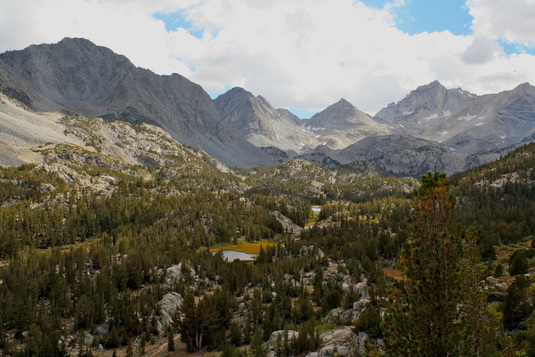
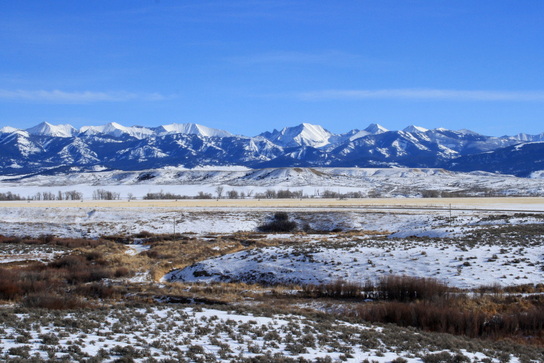
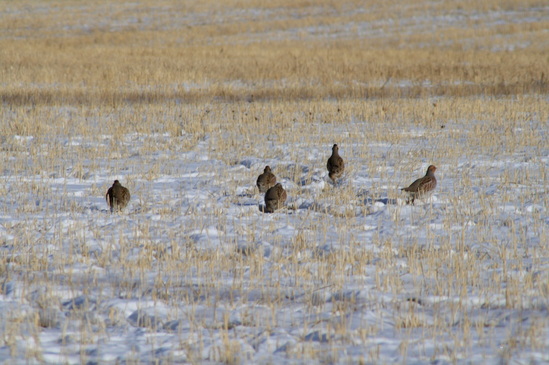
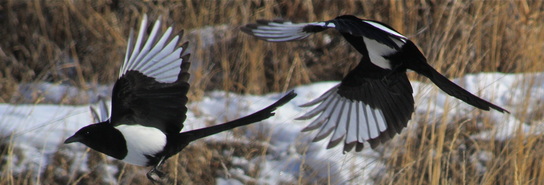
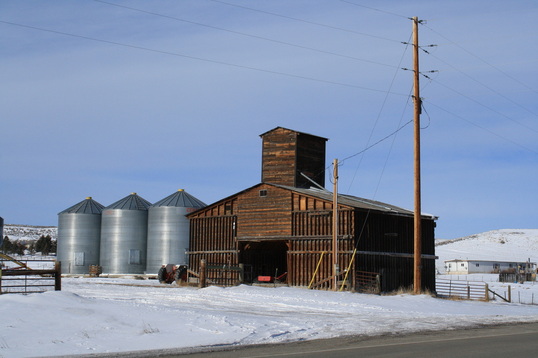

 RSS Feed
RSS Feed